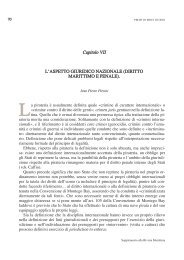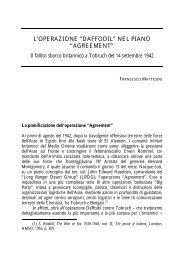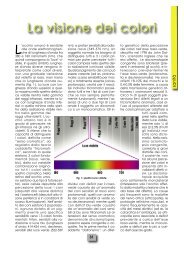143 Anno XVIII - 2008 - Marina Militare
143 Anno XVIII - 2008 - Marina Militare
143 Anno XVIII - 2008 - Marina Militare
You also want an ePaper? Increase the reach of your titles
YUMPU automatically turns print PDFs into web optimized ePapers that Google loves.
32<br />
A NEw SUN ON THE HORIZON?<br />
THE DAwN OF JAPAN’S<br />
ExPEDITIONARy CAPABILITy<br />
Doctor Alessio PATALANO<br />
LAUghTON NAVAL hISTOry SChOLAr<br />
DEpArTMENT Of WAr STUDIES<br />
KINg’S COLLEgE LONDON<br />
IntroductIon<br />
Thursday 23 August 2007 represented a date<br />
of historical significance for Japan’s post-war<br />
defence policy. In a stirring ceremony held<br />
at the Yokohama shipyards of the IHI Marine<br />
United, the launching of Japan’s long-awaited<br />
first flat-top helicopter-carrying destroyer, JDS<br />
Hyuga (DDH-181), marked the country’s return<br />
in the exclusive club of the world’s top class navies.<br />
1<br />
Far from being an isolated episode, the<br />
procurement of this new class of warships is at<br />
the centre of a major transformation of Japan’s<br />
defence policy, which in turn is symptomatic of<br />
the country’s re-emergence as a more confident<br />
political actor in international security and<br />
military affairs. 2 Indeed, as the largest unit<br />
to join the fleet of the Japan Maritime Self-<br />
Defence Force (JMSDF) since its establishment<br />
in 1954, this new platform together with its<br />
sister-ship planned to enter service in 2011,<br />
have been regarded as one of the most evident<br />
signs of Japan’s Post-Cold War ambitions<br />
to move away from its ‘defensive defence’,<br />
acquiring power projection capabilities. 3 In<br />
some cases, analysts argued that the post-9/11<br />
stepping up of Japan’s military empowerment,<br />
encompassing new capabilities and a widened<br />
spectrum of operations, was indicative of a<br />
rather sinister phenomenon named ‘Heisei<br />
militarization’ (from the name of the current<br />
Emperor and reminiscent of the ‘Showa militarization’<br />
of the 1930s). 4 Japan’s more muscular<br />
military endeavour would be part of a plan<br />
to build-up hard power to address increased<br />
regional security concerns and to expand the<br />
strategic partnership with the United States.<br />
Militarization ‘would not be a reversion to the<br />
old stereotype of Japan as addicted to militarism,<br />
but rather the common and dangerous behaviour<br />
of a normal medium-sized state in a militarized<br />
world’. 5 In this respect, some observers consider<br />
the Japanese military phenomenon as part of a<br />
broader and potentially de-stabilising process<br />
of naval arms race in Asia, headed by China<br />
and India. 6<br />
These assessments detailed to a considerable<br />
degree the various internal and external factors<br />
informing Japan’s domestic political debate<br />
on defence issues, but reserved only limited<br />
attention to the military and strategic rationale<br />
underpinning the acquisition of those enhanced<br />
capabilities. The tendency has been to treat<br />
the introduction of new naval combat systems<br />
as empirical evidence of the renewed political<br />
assertiveness of the past decade and a half<br />
rather than as tools of a national strategy. Thus,<br />
considerations on the size and the assets of the<br />
JMSDF’s fleet contributed to fulfil predictions<br />
on Japan’s pursuit of power projection, leaving
















